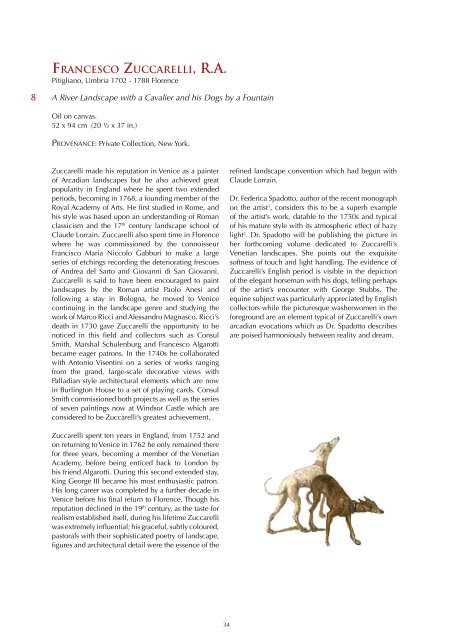Create successful ePaper yourself
Turn your PDF publications into a flip-book with our unique Google optimized e-Paper software.
Francesco Zuccarelli, R.A.<br />
Pitigliano, Umbria 1702 - 1788 Florence<br />
8<br />
A River Landscape with a Cavalier and his Dogs by a Fountain<br />
Oil on canvas.<br />
52 x 94 cm (20 ½ x 37 in.)<br />
Provenance: Private Collection, New York.<br />
Zuccarelli made his reputation in Venice as a painter<br />
of Arcadian landscapes but he also achieved great<br />
popularity in England where he spent two extended<br />
periods, becoming in 1768, a founding member of the<br />
Royal Academy of Arts. He first studied in Rome, and<br />
his style was based upon an understanding of Roman<br />
classicism and the 17 th century landscape school of<br />
Claude Lorrain. Zuccarelli also spent time in Florence<br />
where he was commissioned by the connoisseur<br />
Francisco Maria Niccolo Gabburi to make a large<br />
series of etchings recording the deteriorating frescoes<br />
of Andrea del Sarto and Giovanni di San Giovanni.<br />
Zuccarelli is said to have been encouraged to paint<br />
landscapes by the Roman artist Paolo Anesi and<br />
following a stay in Bologna, he moved to Venice<br />
continuing in the landscape genre and studying the<br />
work of Marco Ricci and Alessandro Magnasco. Ricci’s<br />
death in 1730 gave Zuccarelli the opportunity to be<br />
noticed in this field and collectors such as Consul<br />
Smith, Marshal Schulenburg and Francesco Algarotti<br />
became eager patrons. In the 1740s he collaborated<br />
with Antonio Visentini on a series of works ranging<br />
from the grand, large-scale decorative views with<br />
Palladian style architectural elements which are now<br />
in Burlington House to a set of playing cards. Consul<br />
Smith commissioned both projects as well as the series<br />
of seven paintings now at Windsor Castle which are<br />
considered to be Zuccarelli’s greatest achievement.<br />
refined landscape convention which had begun with<br />
Claude Lorrain.<br />
Dr. Federica Spadotto, author of the recent monograph<br />
on the artist 1 , considers this to be a superb example<br />
of the artist’s work, datable to the 1750s and typical<br />
of his mature style with its atmospheric effect of hazy<br />
light 2 . Dr. Spadotto will be publishing the picture in<br />
her forthcoming volume dedicated to Zuccarelli’s<br />
Venetian landscapes. She points out the exquisite<br />
softness of touch and light handling. The evidence of<br />
Zuccarelli’s English period is visible in the depiction<br />
of the elegant horseman with his dogs, telling perhaps<br />
of the artist’s encounter with George Stubbs. The<br />
equine subject was particularly appreciated by English<br />
collectors while the picturesque washerwomen in the<br />
foreground are an element typical of Zuccarelli’s own<br />
arcadian evocations which as Dr. Spadotto describes<br />
are poised harmoniously between reality and dream.<br />
Zuccarelli spent ten years in England, from 1752 and<br />
on returning to Venice in 1762 he only remained there<br />
for three years, becoming a member of the Venetian<br />
Academy, before being enticed back to London by<br />
his friend Algarotti. During this second extended stay,<br />
King George III became his most enthusiastic patron.<br />
His long career was completed by a further decade in<br />
Venice before his final return to Florence. Though his<br />
reputation declined in the 19 th century, as the taste for<br />
realism established itself, during his lifetime Zuccarelli<br />
was extremely influential; his graceful, subtly coloured,<br />
pastorals with their sophisticated poetry of landscape,<br />
figures and architectural detail were the essence of the<br />
34
















